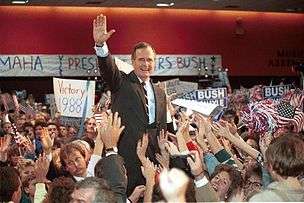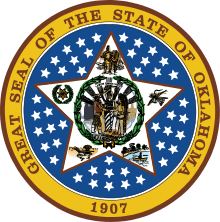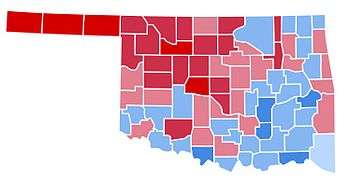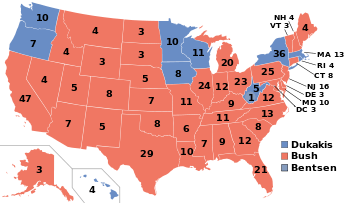United States presidential election in Oklahoma, 1988
| | ||||||||||||||||||||||||||||||||
| ||||||||||||||||||||||||||||||||
| ||||||||||||||||||||||||||||||||
|
| ||||||||||||||||||||||||||||||||
| County Results
Dukakis—60-70%
Dukakis—50-60%
Dukakis—<50%
Bush—50-60%
Bush—60-70%
Bush—70-80% | ||||||||||||||||||||||||||||||||
| ||||||||||||||||||||||||||||||||
The 1988 United States presidential election in Oklahoma took place on November 8, 1988. All 50 states and the District of Columbia, were part of the 1988 United States presidential election. Oklahoma voters chose 8 electors to the Electoral College, which selected the President and Vice President.
Oklahoma was won by incumbent United States Vice President George H. W. Bush of Texas, who was running against Massachusetts Governor Michael Dukakis. Bush ran with Indiana Senator Dan Quayle as Vice President, and Dukakis ran with Texas Senator Lloyd Bentsen.
Oklahoma weighed in for this election as 4% more Republican than the national average.
Partisan background

The presidential election of 1988 was a very partisan election for Oklahoma, with more than 99% of the electorate voting for either the Democratic or Republican parties, and only 4 candidates appearing on the ballot.[1] The Southeastern portion of the state resumed in turning out in large numbers for the Democratic Party, where it voted almost entirely Republican in 1984. This may be somewhat attributed to the influence of the bordering, and politically volatile, state of Texas, which can also be seen changing political orientation through the 80's and 90's from a Democratic area to a largely Republican one.
Republican victory
Bush won the election in Oklahoma with a strong 15 point landslide. While traditionally conservative, the election results in Oklahoma are indicative of a nationwide reconsolidation of base for the Republican Party, which took place through the 1980s. Through the passage of some very controversial economic programs, spearheaded by then President Ronald Reagan (called, collectively, "Reaganomics"), the mid-to-late 1980's saw a period of economic growth and stability. The hallmark for Reaganomics was, in part, the wide-scale deregulation of corporate interests, and tax cuts for the wealthy.[2]
Dukakis ran on a notably socially liberal agenda, and advocated for higher economic regulation and environmental protection. Bush, alternatively, ran on a campaign of continuing the social and economic policies of former President Reagan - which gained him much support with social conservatives and people living in rural areas, who largely associated the Republican Party with the economic growth of the 1980s. Additionally, while the economic programs passed under Reagan, and furthered under Bush and Clinton, may have boosted the economy for a brief period, they are criticized by many analysts as "setting the stage" for economic troubles in the United State after 2007, such as the Great Recession.[3] Dukakis won many counties with a sizable Native American population along Oklahoma's south-eastern counties that had voted for Reagan in his landslide 1984 result. Bush's dominance in the more populated metro Oklahoma city and Tulsa ensured a safe GOP victory.
| Elections in Oklahoma |
|---|
 |
Results
| United States presidential election in Oklahoma, 1988 | |||||
|---|---|---|---|---|---|
| Party | Candidate | Votes | Percentage | Electoral votes | |
| Republican | George H. W. Bush | 678,367 | 57.93% | 8 | |
| Democratic | Michael Dukakis | 483,423 | 41.28% | 0 | |
| Libertarian | Ron Paul | 6,261 | 0.53% | 0 | |
| New Alliance Party | Lenora Fulani | 2,985 | 0.25% | 0 | |
| Totals | 1,171,036 | 100.0% | 8 | ||
See also
References
- ↑ "Dave Leip's Atlas of U.S. Presidential Elections". Uselectionatlas.org. Retrieved 2013-07-21.
- ↑ "Since 1980s, the Kindest of Tax Cuts for the Rich". The New York Times. 2012-01-18. Retrieved 2013-07-21.
- ↑ Jerry Lanson (2008-11-06). "A historic victory. A changed nation. Now, can Obama deliver?". Christian Science Monitor. Retrieved 2013-07-21.



